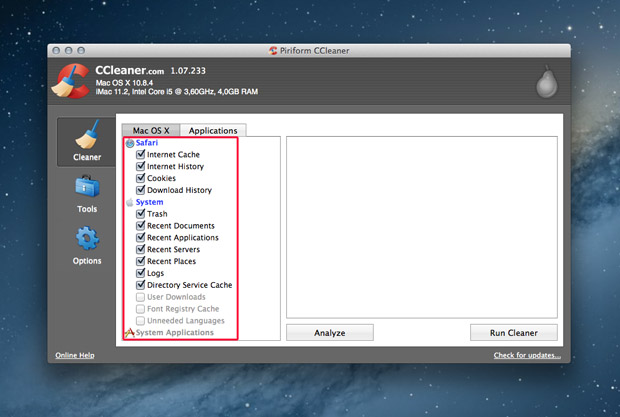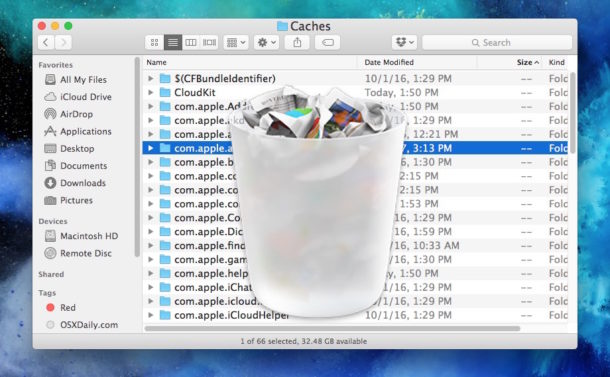H D Mac Cleaner
If cleaning the System Storage is still not enough to bring your Mac available disk space to a normal level (i.e. 20% or more), see below. What Else Can I Do to Reclaim More Disk Space? There are tons of ways out there. Here are a few of my favorites that should help you get back a decent amount of space quickly. Question: Q: Which is the best Mac system cleaner app? As a recently converted mac user I am interested to see if there is a Mac equivalent to pc's 'disk cleanup' and a defragger. I know mac's are far more robust than pc's but they surely need a clean every so often.
So, your Mac is running out of storage. You try to figure out what’s taking up your disk space by clicking the Apple logo on the top-left of the screen, selecting About This Mac, and hitting the Storage tab.
To your surprise, you see a yellow bar representing “System” that seems to occupy way more space than you think it should. In the example above, it only shows 33.87 GB, but take a look at this Apple discussion — some Mac users report that System Storage takes an astonishing 250 GB.
Worse yet, you have no idea what’s included in “System” storage, because clicking the “Manage” button brings you to this System Information window… and the “System” row is greyed out.
Why does my Mac system require so much space?
What does it contain?
Is it safe to remove some of those system files?
How do I regain more storage space?
Questions like these may easily get to your head. Although my Mac now has a good amount of disk space available, I’m always wary of files that are taking up more space than they should.

I have no idea why “System” is greyed out while “Documents,” “System Junk,” “Trash,” etc. allow you to review the files based on size and type. My hunch is that Apple does this on purpose to prevent users from deleting system files that could lead to serious issues.
What Files Are Included in System Storage on Mac?
During my research, I found many people report that Apple counts iTunes backup files and app caches (e.g. Adobe video cache files) in the System category.
Since it’s greyed out and we are unable to click on that category for deeper analysis, we’ll have to use a third-party app to assist.
CleanMyMac X is perfect for this kind of analysis. Since I tested the app in our Mac cleaner review, it immediately came to my head when I saw “System” was greyed out in Storage. Note that CleanMyMac isn’t freeware, but the new “Space Lens” feature is free to use and it allows you to scan your Macintosh HD, and then show you an in-depth overview of what’s taking up disk space on your Mac.
Step 1:Download CleanMyMac and install the app on your Mac. Open it, under “Space Lens” module, first click the yellow “Grant Access” button to allow the app to access your Mac files and then select “Scan” to get started.
Step 2: Soon it’ll show you a folder/file tree and you can hover your cursor over each block (i.e. a folder). There you can find more details. In this case, I clicked “System” folder to continue.
Step 3: The file breakdown below indicates that some Library and iOS Support files are the culprits.
The interesting part is that the System file size shown in CleanMyMac is much smaller than the size shown in System Information. This puzzles me and makes me believe that Apple definitely has counted some other files (not real system files) in the System category.
What are they? I have no clue, honestly. But as reported by other Mac users who experienced the same issue, they said Apple also considers app caches and iTunes backup files as System files.
Out of curiosity, I ran CleanMyMac again for a quick scan. That app found 13.92 GB in iTunes Junk. Further review revealed that the junk files are old iOS device backups, software updates, broken downloads, etc.
But even after adding this amount to the original system files returned by DaisyDisk, the total size is still a bit less than what’s returned in System Information.
If cleaning the System Storage is still not enough to bring your Mac available disk space to a normal level (i.e. 20% or more), see below.
Clean Macbook Hard Drive
What Else Can I Do to Reclaim More Disk Space?
There are tons of ways out there. Here are a few of my favorites that should help you get back a decent amount of space quickly.
1. Sort all files by size and delete old large files.
Open Finder, go to Recents, and look at the Size column. Click on it to sort all recent files by file size (from large to small). You’ll have a clear overview of what items are eating up a large amount of space, e.g. From 1 GB to 10 GB, and from 100 MB to 1 GB.
In my MacBook Pro, I found a few large videos that could be transferred to an external drive.
Note: If the Size column doesn’t show up, click on the Settings icon and select Arrange By > Size.
Mac Cleaner Virus
2. Run CleanMyMac.
If you are not a power Mac user, another way to help you quickly locate unnecessary files is using CleanMyMac, an app that won our award for the best Mac cleaner software. As you can also see in my detailed review here, I believe CleanMyMac is a must-have app for all basic users.
3. Remove duplicate files with Gemini 2.
Don’t forget those duplicates and similar files! They can stack up without you being aware of it. Finding them is sometimes time-consuming. That’s what Gemini 2 is designed for. Simply select a few frequently used folders (e.g. Documents, Downloads, etc.) in the main zone of Gemini.
It then scans them and returns all the duplicate files that might be worth removing. Of course, it’s always a good practice to review them before doing so. You can also read our Gemini review here.
Wrapping It Up
Ever since Apple introduced the Optimized Storage feature on macOS Sierra and High Sierra, users got the option of saving space by storing content in the cloud. Apple also has several new tools that make it easy to find and remove unneeded files.
That bar under the Storage tab is beautiful. It does allow you to get a quick overview of what’s taking up the most space on our hard drive. However, it still lacks insights on the “System” category as it’s greyed out.
Hopefully, the guides above have helped you figure out the reasons you’ve got so much “System” data, and most importantly you’ve reclaimed some disk space — especially for new MacBooks pre-installed with flash storage (usually 128 GB or 256 GB) — the storage is so precious!
Here are some general tips to keep your Mac's hard drive trim and slim as possible
Free Hard Drive Cleaning Software
You should never, EVER let a conputer hard drive get completely full, EVER!
With Macs and OS X, you shouldn't let the hard drive get below 15 GBs or less of free data space.
If it does, it's time for some hard drive housecleaning.
Follow some of my tips for cleaning out, deleting and archiving data from your Mac's internal hard drive.
Have you emptied your Mac's Trash icon in the Dock?
If you use iPhoto or Aperture, both have its own trash that needs to be emptied, also.
If you store images in other locations other than iPhoto, then you will have to weed through these to determine what to archive and what to delete.
If you are an iMovie user, iMovie has its own individual Trash location that needs to be emptied, too!
If you use Apple Mail app, Apple Mail also has its own trash area that needs to be emptied, too!
Delete any old or no longer needed emails and/or archive to disc, flash drives or external hard drive, older emails you want to save.
All of these tools can be easily accessed from a very nicely designed user interface.The Mac Clean section of Omni Remover offers complete cleanup of your Mac. You begin by running a scan of your system for things like accumulated cache junk, broken logins, redundant language files, orphaned apps leftover files, internet browser junk, unwanted language junk and so on. According to the developer, it is able to scan and remove more than twenty different types of junk files.Omni Remover offers intelligent apps removal. Free junk file cleaner for mac.
Look through your other Mailboxes and other Mail categories to see If there is other mail you can archive and/or delete.
STAY AWAY FROM DELETING ANY FILES FROM OS X SYSTEM FOLDER!
Look through your Documents folder and delete any type of old useless type files like 'Read Me' type files.
Again, archive to disc, flash drives, ext. hard drives or delete any old documents you no longer use or immediately need.

Look in your Applications folder, if you have applications you haven't used in a long time, if the app doesn't have a dedicated uninstaller, then you can simply drag it into the OS X Trash icon. IF the application has an uninstaller app, then use it to completely delete the app from your Mac.
To find other large files, download an app called Omni Disk Sweeper.
Download an app called OnyX for your version of OS X.
When you install and launch it, let it do its initial automatic tests, then go to the cleaning and maintenance tabs and run the maintenance tabs that let OnyX clean out all web browser cache files, web browser histories, system cache files, delete old error log files.
Typically, iTunes and iPhoto libraries are the biggest users of HD space.
move these files/data off of your internal drive to the external hard drive and deleted off of the internal hard drive.
How To Clean Mac Drive
If you have any other large folders of personal data or projects, these should be archived or moved, also, to the optical discs, flash drives or external hard drive and then either archived to disc and/or deleted off your internal hard drive.
Moving iTunes library
Moving iPhoto library
Moving iMovie projects folder
Good Luck!